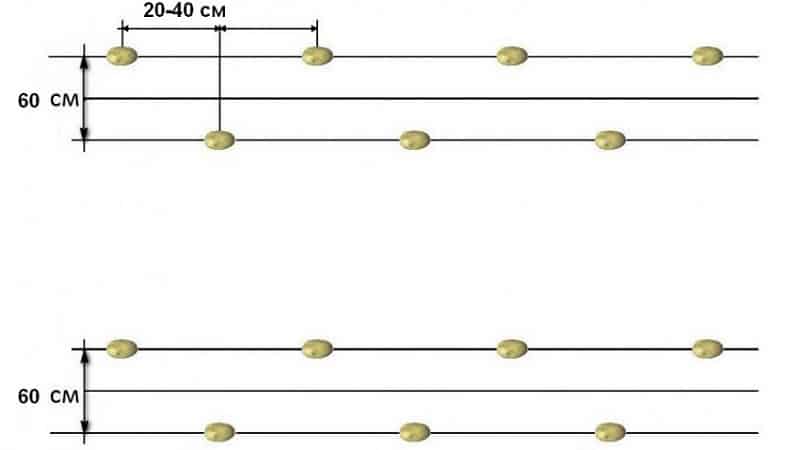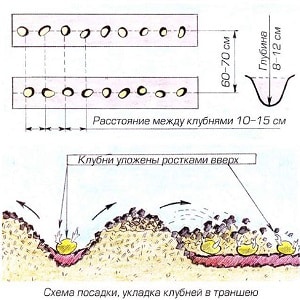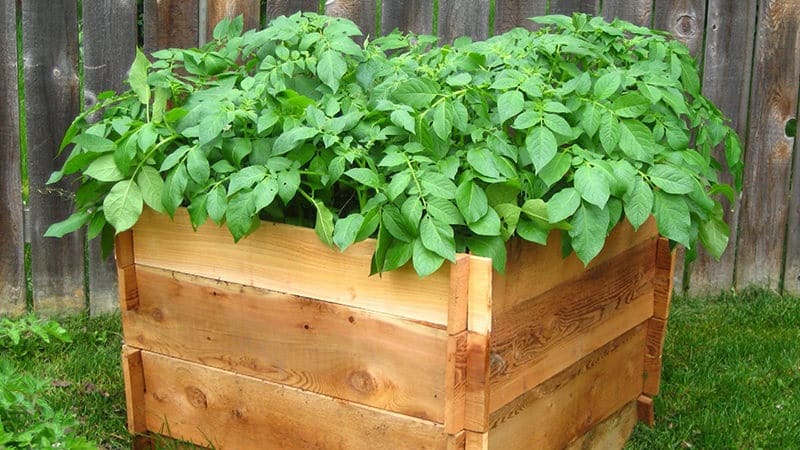What is the distance between rows when planting potatoes?
The key to success in obtaining a high yield lies in knowledge of the features of agricultural technology. The correct distance between beds and rows when planting potatoes ensures a bountiful harvest. In this article we will tell you at what distance to plant potatoes and propose the most effective schemes.
Features of planting potatoes
Choose a place for planting that is illuminated by the sun, without shade from trees.. Potatoes prefer loose soil and do not tolerate excess moisture and stagnant water. If there is such a problem, drainage ditches are constructed and soil is added to raise and level the area.
When planting, take into account the soil temperature. Planting work begins when the earth warms up to +10°C, in late April - early May, depending on the climatic characteristics of the region.
Pre-landing activities are carried out soil preparation:
- In the fall, after harvesting (August - October, depending on the region), they dig, loosen, and apply fertilizer. It is better to use potassium-phosphorus mixtures, which will remain in the soil for a long time.
- In the spring, they dig it up again and feed it with complex mineral fertilizers containing nitrogen.

What you need for work
Before the beginning planting crops prepare tools and materials:
- bayonet shovels;
- pitchfork;
- buckets;
- cotton gloves;
- pegs for distinguishing varieties;
- fertilizers for application directly into the hole;
- water (in case of insufficient soil moisture).
Planting schemes and technology
Knowledge of planting schemes and correct technologies determines the quality and amount of harvest. Each technology has nuances that need to be taken into account.
Why determine the distance between rows
The width of potato rows affects the volume and quality of grown tubers, on the rational use of the usable area of the garden plot. The ease of access to each bush when caring depends on the selected distance.
If the distance between the rows is insufficient, the bushes do not receive nutrients, grow weak, bring a small harvest.
The abundance of free space from row to row leads to the redirection of plant forces: all the force is directed to the growth of tops; few large tubers grow.
At what distance to plant tubers?
Depending on the variety, determine at what distance to plant potatoes from each other:
- early varieties - 25-30 cm;
- late – 30-35 cm.
The specified parameters are suitable for standard potatoes. For small seed, the distance between tubers is reduced to 18-20 cm. Large tubers are planted at a distance of 45 cm from each other.
To what depth
It is considered correct hole depth within 7-10 cm. These parameters allow the tubers to warm up faster and sprout.
Important! When planting late, the depth of the holes is increased to 13 cm.
When choosing the optimal depth, they are guided by the quality of the soil. If the substrate is loose, plant deeper. Dense and moist soil favors slight burying of tubers.
Sowing potatoes using a walk-behind tractor ensures the hole depth is within 12 cm.

How to make a furrow
Loose soil saturated with oxygen is suitable for forming furrows.. To do this, dig up the soil with a shovel or plow to a depth of 25 cm.Then the plantings will have free access to air.
When preparing furrows, preference is given to the direction from north to south, as this allows for proper lighting of the bushes at sunrise, midday and sunset.
Row spacing
To obtain a high yield, they opt for row spacing 90 cm wide.. The generally accepted distance among gardeners is 70 cm.
When forming beds in small areas use a distance between them of 19-26 cm (the width of one shovel), and the seed is sown in two rows.
The optimal distance between two rows of potatoes varies depending on the variety used:
- 60-75 cm – for early ripening varieties;
- 70-90 cm - for late ripening.
Generally accepted row seating carried out according to the 30x80 cm pattern.
Landing
There are many ways to plant a crop. We offer the most popular options that have proven themselves well.
On the ridge
Ridges for planting tubers are prepared according to instructions:
- The rows are arranged from north to south, marking them with a stretched rope from each other at a distance of 70-75 cm.
- 30-35 cm are retreated from the rope and a groove is made, which subsequently serves as a path.
- The ridges are identified using a shovel or glander, without digging out the soil from the paths. The ridges are formed by the top layer of soil, which has warmed up at the time of planting.
- The comb is created in the form of a trapezoid, with the narrow side (up to 15 cm in size) facing up. The height of the mound is 20-31 cm.
- The holes are made by hand, moving away some of the soil.
- After laying the tuber, fill the hole with loose soil.

Basic rules for planting in ridges:
- light sprouts for seed potatoes - no more than 5 mm;
- planting depth – 4-8 cm;
- the distance between tubers is 30-35 cm.
Under the shovel
There are two ways to plant seed under a shovel.:
- in a checkerboard pattern;
- in line.
Linear planting assumes the distance between rows 60 cm (70 cm for late-ripening varieties), between holes – 30 cm.
The holes are made shallow due to the cold lower layers of soil. It is optimal to plant the tubers to a depth of 10 cm. In case of late planting dates or the presence of clay soil, this figure is reduced by 4 cm.
Planting process: dig holes, place potatoes in them with sprouts up and cover them with soil. The land remaining between the rows will be needed for further hilling of the seedlings.
In the trench
When growing using this method, up to a ton of potatoes are collected from one hundred square meters. The advantage of the method is that there is no need to use fertilizers.
Preparing trenches in the fall:
 The trenches are located from north to south, and a cord is pulled for evenness.
The trenches are located from north to south, and a cord is pulled for evenness.- The length is determined in accordance with the size of the plot, the width is about 40 cm. The distance from one to the other is 65-70 cm.
- The excavated soil is placed on one side of the trench.
- Fill the grooves with organic matter - weeds, tops, food waste, husks, and mown grass.
- Fallen autumn leaves are compacted in the fall. Cover with earth.
In the spring, before planting, lay litter from onion peels, dry bird droppings and ash. Seed potatoes are placed on the prepared litter and sprinkled with soil from the ridges.
Important! To prevent infection of planting material, tops of potatoes and tomatoes are not used, as infections may remain on them.
In a container
The essence of the method in the use of containers for planting with the possibility of extending walls as the bushes grow.
Four pillars (rebar, stakes) are dug into the ground.The walls of the container are built from boards by attaching them to poles with wire. The walls are built up gradually as the potatoes grow.
The bottom is made ventilated, so first a few bricks are laid, and boards are laid on them. The distance between the boards will ensure ventilation.
After preparing the first floor of boards, the resulting niche is filled with a light organic composition. Ideally, humus with expanded clay screenings, taken in equal parts. Then the sprouted tubers are laid. When sowing early, cover them with film.
When the tops reach the “second floor,” a second level of boards is completed and soil is added.
The construction of walls and the addition of soil continue until the buds appear. To delay their appearance, the soil in the container is watered with manure compost, and the container is protected from overheating. After the buds appear, the addition of floors is completed. Further care consists of feeding, watering, and protection from diseases.
Harvesting start by disassembling the container.

Recommendations and advice from experienced gardeners
Experienced gardeners begin preparing to create beds immediately after harvesting.. In the fall, fertilizers are applied, soil and bedding are prepared from organic substrates. In the spring, the beds are dug up and fertilizers are added if necessary.
Farmers are of the opinion that the north-south direction of the beds is necessary to obtain a rich harvest.
Recommendations from experienced gardeners:
- Before planting, potatoes are germinated: left in the light for 20-40 days or placed in a container with wet sawdust, moss, and humus for 15 days.
- For planting, use only healthy tubers without damage, cracks, rot or mold.
- To speed up the harvest, potatoes are grown under black film or non-woven material. The area is fertilized (per 10 liters of water - 30 g of potassium chloride, 1 g of copper sulfate and 60 g of superphosphate) and covered with film. Holes 10x10 cm are made in it and sprouted tubers are planted.
- After harvesting in containers, the area is planted with green manure. Next year you can plant potatoes in this place again.
- To be sure of a rich harvest, furrows are prepared in the fall, and potatoes are planted in them in the spring.
Conclusion
The average statistical indicator for obtaining a potato harvest in Russia from 1 hundred square meters is 150 kg with the standard planting method. Experimenting with different growing methods and changing planting patterns can increase crop yields.